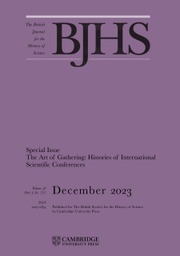Bound by Muscle was not the book Andrew Brown set out to write. Brown had intended to explore the lives of several near contemporaries at Trinity College, Cambridge, in the early twentieth century. But, as he confesses in the preface, he found himself intrigued by the friendship between one of these Cantabrigians, Archibald Vivian Hill (1886–1977), and the German physician and biochemist Otto Fritz Meyerhof (1884–1951), whose collaboration earned them the 1922 Nobel Prize in Physiology or Medicine for their contributions to muscle physiology. Brown’s account emerges as a meticulously researched and effective dual biography of the pair.
The book opens at the breakfast table, with A.V. Hill learning from his wife that he had won the Nobel Prize. This ordinary setting for such a significant moment sets the tone for a work that deftly balances the deeply personal with the scientific. From this fixed point, Brown unfolds the narrative chronologically across thirteen chapters, and his narrative form enhances the image of the pair’s complementarity. Hill’s early life and career are covered in Chapters 1 and 2, whilst Chapter 3 focuses on Meyerhof’s. The remaining chapters explore their discoveries leading up to the Nobel Prize, the effects of the world wars, and their broader contributions to science through their legacies. The chronological structure provides a clear framework, allowing Brown to explore the contrasts between the two men’s approaches to science and life: Hill’s fairly pragmatic approach and Meyerhof’s more introspective style. Hill’s scientific style led him to pioneer the field of exercise physiology, where he introduced the concept of ‘oxygen debt’. Meyerhof, in contrast, brought a more philosophical lens to his work, uncovering enzymes and metabolic pathways that highlighted the universal nature of biochemical reactions across all living organisms.
Known for his previous scientific biography of J.D. Bernal, Brown builds on his expertise in scientific biography by effectively moving beyond the single-subject format to explore collaborative dynamics. Bound by Muscle’s dual focus achieves a depth that would not have been possible through a close study of either figure alone, and the book’s appeal lies in its ability to interweave personal anecdotes with the broader scientific and historical contexts that shaped Hill and Meyerhof’s lives.
Brown makes use of the excellent earlier technical work of Chris Barclay and Nancy Curtin (2022), weaving it judiciously into his narrative. His choice of what to include maintains a careful balance between accessibility and depth. His treatment of the mathematics and experimental work underlying muscle energetics is satisfying and clear, striking a good balance between complexity and explanation; readers without specialist knowledge of either mathematics or physiology can still follow the narrative. This technical work is combined with a wealth of anecdotes – such as Hill’s aversion to his own middle name – which grounds the scientific achievements in relatable human experiences, ensuring that the narrative remains engaging and approachable. This is the book’s standout feature.
Brown has meticulously navigated Hill’s various archives, uncovering insights into his scientific and personal life. Through the pair’s correspondence we then see Meyerhof’s reluctance to leave Heidelberg during the rise of Nazism, his disdain for German academics who aligned themselves with the Nazi regime, and his eventual escape from Germany. This not only disrupted Meyerhof's scientific work, but also contributed to the fragmentation of his own archive, which is most noticeable in Chapter 3. Meyerhof’s displacement from occupied Europe between 1938 and 1940, navigating first France, then Spain, before finally reaching the United States, underscores the broader human and intellectual cost of fascism. Brown’s discovery of Meyerhof’s letters to his children provide some insights into his personal life, helping to reconstruct a fuller narrative, but also remind us of how such displacements lead to archival silences that shape the narratives historians can reconstruct.
The formatting choices, particularly the use of block quotes in shaded backgrounds, might pose minor accessibility challenges for readers who rely on consistent text flow. Additionally, some readers may find the biographical style less conceptually analytical, as it consciously prioritizes the narrative. However, Brown’s selected bibliography shows his awareness of how his work will contribute to broader discussions about global science and medicine in the twentieth century, ensuring its value as a foundation for future research in those fields too.
Bound by Muscle reaps the rewards of pursuing unanticipated historical projects. It is an important biographical contribution rooted in detailed archival research, capturing the essence of its subjects with nuance and clarity. While the book Brown originally intended to write about the so-called Cambridge Four is (hopefully) a review for another time, the unexpected emergence of Bound by Muscle offers a narrative well worth Brown’s detour. By intertwining the personal and scientific, Bound by Muscle offers a compelling reminder of the power of cooperation amidst upheaval – a story that will continue to resonate with readers across disciplines. The chairman of the Nobel Committee for Physiology or Medicine, Professor J.E. Johansson, remarked that Hill and Meyerhof’s joint award exemplified how ‘the greatest cultural advances [are] independent of the splitting-up of mankind into contending nations’ (award ceremony presentation speech, 10 December 1923). Brown’s book mirrors Johansson’s sentiment: it forms a timely reminder of the value of scientific friendships and collaborations that transcend borders.



